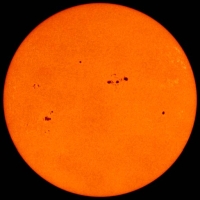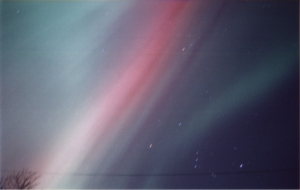¡SkyCaramba! Weekly astronomy blog for the week ending June 16, 2012
If you used a telescope—safely—to view the solar eclipse or the transit of Venus during the last few weeks, you certainly noticed a few dark spots on the sun. After a second or two, you know whether a spot is a bird, airplane, or cloud fragment because those quickly get out of the way. If it doesn’t go away and looks like a dirty smudge on the sun’s face, you’re looking at a sunspot.
Sunspots aren’t actually black or brown spots on the sun. They look that way because of an optical illusion. A sunspot is a relatively cool area on the sun. The cooler areas don’t glow as brightly. To our eyes taking in the entire disk of the sun, sunspots look very dark.
 We say sunspots are relatively cool, because they’re actually still rather hot. The surface of the sun is 5,780 Kelvin or 9,944 Fahrenheit where there is no sunspot. Where there is a sunspot, it’s around 3,500 Kelvin or 5,840 Fahrenheit.
We say sunspots are relatively cool, because they’re actually still rather hot. The surface of the sun is 5,780 Kelvin or 9,944 Fahrenheit where there is no sunspot. Where there is a sunspot, it’s around 3,500 Kelvin or 5,840 Fahrenheit.
Sunspots appear to be caused by magnetic activity in the sun. The hot plasma that makes up our parent star aligns itself in magnetized flowing tubes. Sometimes the tubes reach the sun’s surface in a way that interferes with the transfer of heat from inside the sun to the sun’s surface. The spots where less heat surfaces are sunspots, according to this understanding.
The magnetic patterns coming out of a sunspot can make things interesting on Earth. Now and then, a solar flare erupts from the area by a sunspot. The flare will carry solar plasma out into space. If the plasma particles reach Earth, our planet’s own magnetic field will shuttle them through the atmosphere where they can cause the night sky to light up in red, green, and a few other colors. This phenomenon is called the aurora. It’s a regular and frequent occurrence near the north and south poles. Stronger aurorae are visible farther from the poles.
 Those solar particles can also jumble the electronics inside satellites and electrical transmission systems on Earth. A power outage in Canada in 1989 is blamed on a solar flare and subsequent aurora so strong, skies over Mexico glowed red. Telegraph operators had to put out fires in 1859 during a bright auroral display.
Those solar particles can also jumble the electronics inside satellites and electrical transmission systems on Earth. A power outage in Canada in 1989 is blamed on a solar flare and subsequent aurora so strong, skies over Mexico glowed red. Telegraph operators had to put out fires in 1859 during a bright auroral display.
We’re fortunate most sunspots don’t cause such dramatic effects on Earth. We’re also fortunate they do regularly cause a much milder effect. Sending radio signals around the world would have been much harder in radio’s early days without some of the sun’s charged particles causing layers of particles in the Earth’s atmosphere to become charged. The layer of charged particles is called the ionosphere. It acts somewhat like a mirror for radio waves at certain frequencies. Some radio signals can bounce several times between the earth and the ionosphere and travel around the world.
 The number of sunspots visible on the face of the sun varies. A sunspot can be there for as little as one day. Or it could be there for up to three months. Since the sun rotates in a little less than one month, a sunspot that lasts at least that long will disappear on the other side of the sun and come back around. There could be no sunspots visible for a few days. Or there could be a few dozen. And over an average of 11 years, the number of sunspots will rise from few to none to a maximum and drop to few to none again.
The number of sunspots visible on the face of the sun varies. A sunspot can be there for as little as one day. Or it could be there for up to three months. Since the sun rotates in a little less than one month, a sunspot that lasts at least that long will disappear on the other side of the sun and come back around. There could be no sunspots visible for a few days. Or there could be a few dozen. And over an average of 11 years, the number of sunspots will rise from few to none to a maximum and drop to few to none again.
Always view the sun safely. Use a solar filter on a telescope for the best results. If you don’t have that, you can use binoculars or a cheap toy telescope to briefly project the sun’s image. But don’t be surprised if there’s a sunspot big enough to see with the naked eye once every few years. Just don’t actually look at it with the naked eye. Use a solar filter for that too.
¡SkyCaramba!
Here are some links to more articles about sunspots:
http://hyperphysics.phy-astr.gsu.edu/hbase/Solar/sunspot.html
http://earthguide.ucsd.edu/virtualmuseum/climatechange2/06_3.shtml
http://tuftsjournal.tufts.edu/2010/03_1/professor/01/